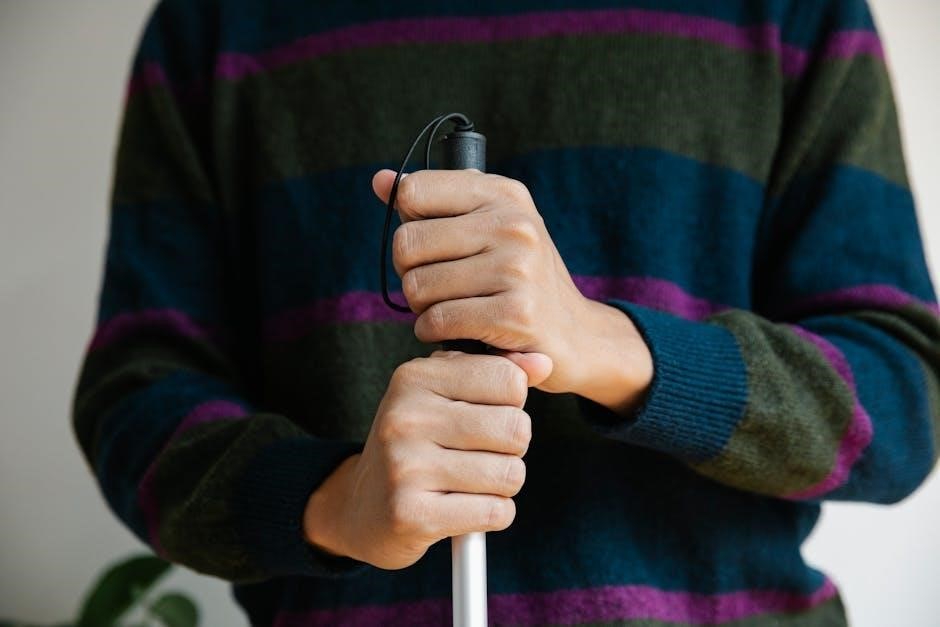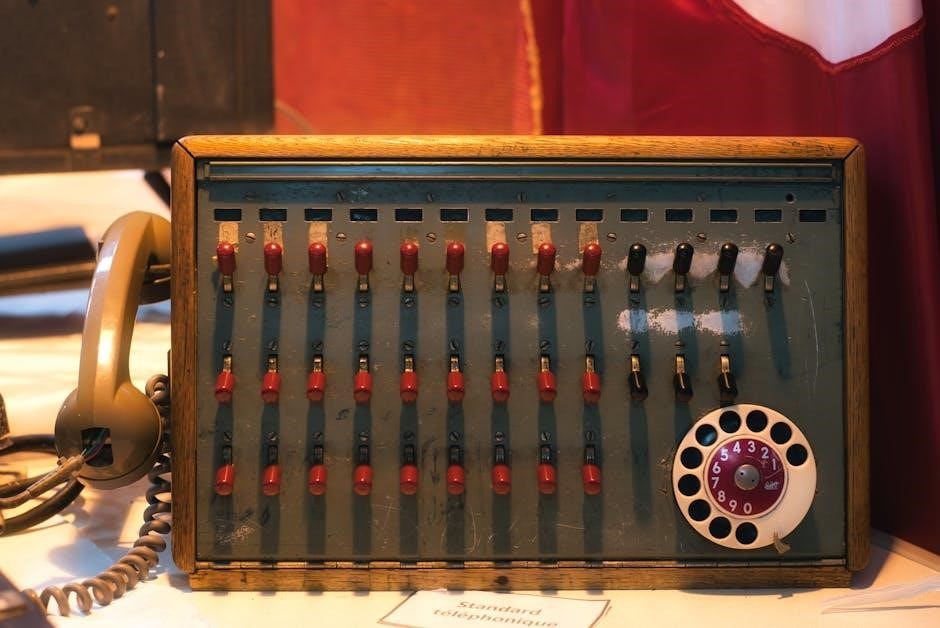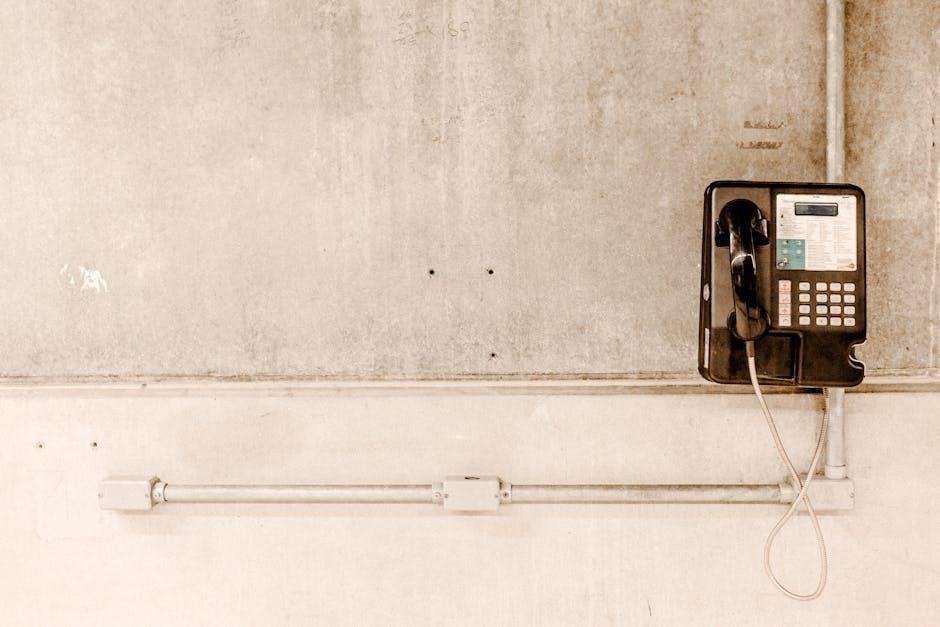
Phone wiring is the backbone of reliable communication systems, connecting devices through cables, jacks, and plugs․ Understanding its basics ensures clear connections and network reliability, essential for modern communication․
1․1 Importance of Proper Phone Wiring
Proper phone wiring ensures reliable communication and minimizes interference․ It supports advanced features like VoIP and future expansions, while preventing safety hazards and maintaining a professional appearance․
1․2 Brief History of Telephone Wiring
Telephone wiring has evolved significantly since its inception in the late 19th century․ Early systems used basic pair cables, which were prone to interference․ The 20th century saw advancements with twisted pair cables, reducing noise and improving clarity․ The introduction of PBX systems allowed businesses to manage multiple lines internally․ Modern telephone wiring incorporates Cat5e and Cat6 cables, supporting higher bandwidths and integration with VoIP systems․ This evolution reflects the growing demand for reliable communication technologies․

Understanding Phone Wiring Basics
Phone wiring involves understanding cables, jacks, plugs, and connections․ It ensures reliable communication by linking devices through structured networks, essential for clear and uninterrupted service․
2․1 Types of Phone Cables
Phone cables vary in type and purpose, ensuring reliable connections․ Twisted-pair cables are common, reducing interference․ Coaxial cables offer higher bandwidth for internet․ Fiber optic cables provide fast, long-distance data transmission․ Each type suits specific needs, ensuring clarity and efficiency in communication systems․
2․2 Understanding Phone Jacks and Plugs
Phone jacks and plugs are essential for connecting telephones to wiring systems․ Jacks are wall-mounted or surface-mounted sockets, while plugs attach to phone cords․ Common types include RJ-11 for standard phones and RJ-45 for Ethernet․ Proper installation ensures reliable connections; Over time, wear and tear can cause issues like static or disconnections․ Regular maintenance, such as cleaning or replacing worn-out plugs, is crucial for optimal performance․ Understanding compatibility between jacks and plugs is key to avoiding connection problems․ Secure connections prevent signal loss, ensuring clear communication․ Always use high-quality materials to maintain durability and functionality in your phone wiring setup․
2․3 Basic Phone Wiring Tools
Essential tools for phone wiring include wire strippers, cable cutters, and punch-down tools․ Wire strippers remove insulation without damaging wires, while cable cutters trim cables to the right length․ Punch-down tools securely connect wires to jacks․ A multimeter can test wire conductivity, ensuring proper connections․ Cable testers verify signal strength and detect faults․ Prying tools help remove old or damaged cables․ Label makers keep wires organized․ Drill bits and fish tape aid in running cables through walls․ Safety gear, like gloves, protects during installation․ Having these tools ensures efficient and professional phone wiring, reducing errors and improving reliability․ Proper tool maintenance is crucial for long-term performance․

Planning Your Phone Wiring Setup
Planning your phone wiring involves assessing communication needs, determining line numbers, selecting jack locations, and creating a wiring diagram․ This ensures efficient and organized connectivity for all users․
3․1 Determining the Number of Phone Lines Needed
Determining the number of phone lines needed involves evaluating household or business communication requirements, including voice, fax, and internet services․ Assessing peak call volume helps avoid network overload and ensures reliable connectivity for all devices․ Consider future expansion needs to prevent the necessity for costly upgrades later․ By accurately calculating the required phone lines, you can establish a scalable and efficient wiring setup tailored to your specific needs, ensuring seamless communication and optimal performance․
3․2 Choosing the Right Locations for Phone Jacks
Choosing the right locations for phone jacks involves considering accessibility, convenience, and aesthetic preferences․ Install jacks in areas where phones will be frequently used, such as living rooms, home offices, and bedrooms․ Consider the layout of each room to minimize cable clutter and ensure easy access․ Think about future needs, like adding new devices or rearranging furniture, to avoid relocating jacks later․ Additionally, placing jacks near power outlets can simplify setup for devices requiring electricity․ By strategically positioning phone jacks, you create a practical and visually appealing wiring system tailored to your lifestyle and communication demands․
3․3 Creating a Wiring Diagram
A wiring diagram is a detailed visual representation of your phone wiring system, illustrating connections between devices, jacks, and the main panel․ It helps plan and organize the setup efficiently․ Use symbols to represent components like phones, jacks, and cables․ Clearly label each part and indicate connections with lines․ Color coding can differentiate between various phone lines or cable types․ This diagram ensures clarity during installation and simplifies future modifications or troubleshooting․ Create the diagram on paper or use software tools for accuracy․ A well-designed wiring diagram saves time and reduces errors, making it an essential step in planning your phone wiring system effectively․

Tools and Materials Required
Essential tools include wire cutters, strippers, crimping tools, and cable testers․ Materials needed are phone cables, jacks, plugs, and connectors to ensure a stable connection setup․
4․1 Essential Tools for Phone Wiring
Key tools for phone wiring include wire cutters, strippers, crimping tools, and cable testers․ Wire cutters trim cables, while strippers remove insulation․ Crimping tools secure connectors, and testers ensure connectivity․
4․2 Types of Cable and Connectors
Common phone wiring cables include twisted-pair and coaxial․ Twisted-pair is standard for landlines, reducing interference․ Coaxial cables support higher frequencies․ Connectors like RJ-11 and RJ-45 are widely used, ensuring secure connections for reliable communication systems․
4․3 Safety Equipment
When working with phone wiring, safety equipment is crucial to prevent injuries and ensure protection․ Essential items include insulated gloves, safety goggles, and a voltage tester to detect live wires․ A cable tester helps verify connectivity without risking electric shock․ Proper cable management tools, like cable ties and organizers, prevent tripping hazards and maintain a neat setup․ Fire-resistant cable sleeves can protect wires from heat damage․ Always use a first aid kit and follow safety guidelines to minimize risks during installation and maintenance․ These tools and precautions help create a secure environment for effective phone wiring projects․

Installing Phone Wiring
Installing phone wiring involves running cables through walls, connecting wires to the phone panel, and installing jacks․ This step is critical for ensuring proper connectivity and reliability․

5․1 Running Cables Through Walls
Running cables through walls requires careful planning to avoid obstructions․ Start by mapping the route and drilling pilot holes․ Use fish tapes or cable rods to guide wires through walls․ Ensure cables are secured with clips or conduit for protection․ Choose the right tools, such as a drill and wire strippers, to simplify the process․ Always turn off power before drilling near electrical systems․ Test the cable continuity after installation to ensure proper connections․ For complex setups, consider hiring a professional to avoid damage or safety hazards․ Properly labeled cables will make future maintenance easier and more efficient․
5․2 Connecting Wires to the Phone Panel
Connecting wires to the phone panel is a critical step in ensuring reliable communication․ Begin by identifying the correct terminals on the panel, typically color-coded for simplicity․ Strip the insulation from the wires using a wire stripper and connect them to the corresponding terminals․ Use a screwdriver to secure the wires firmly․ Double-check the connections to avoid any loose wires, which can cause signal loss․ After connecting, test the line using a phone to ensure proper functionality․ If issues arise, verify the connections or consult a professional․ Properly connected wires ensure clear communication and prevent future disruptions․
5․3 Installing Phone Jacks and Outlets
Installing phone jacks and outlets requires careful planning and precision․ Begin by locating the jack near a desk or desired connection point․ Use a utility knife or saw to cut a small hole in the wall for the outlet․ Run the cable through the hole and secure it with cable clips․ Attach the wires to the terminals on the phone jack, ensuring colors align correctly․ Tighten the screws firmly․ Finally, test the connection by plugging in a phone to verify functionality․ If issues arise, double-check the wiring or consult a professional for assistance․ Proper installation ensures reliable communication and lasting performance․

Testing and Troubleshooting
Testing ensures phone lines function properly, while troubleshooting identifies and resolves connectivity issues․ Use line testers to verify signal strength and diagnose common wiring faults efficiently․
6․1 Testing Phone Lines for Connectivity
Testing phone lines ensures they are functioning correctly and provides a clear connection․ Start by using a line tester to check for dial tone and signal strength․ Verify that all jacks are properly connected and functioning․ Listen for static or interference, which may indicate faulty wiring․ Check for short circuits or open circuits using a multimeter․ Ensure all connections are secure and meet industry standards․ Test each line individually to isolate any issues․ Document the results to identify patterns or recurring problems․ This step is crucial before integrating the lines into your phone system․ Regular testing helps maintain reliable communication and prevents future outages․
6․2 Identifying Common Wiring Issues
Common wiring issues include poor connections, which can cause static or dropped calls, and incorrect wiring configurations that lead to no dial tone․ Loose or corroded connectors are frequent problems, as they disrupt signal flow․ Physical damage to cables, such as cuts or bends, can also impair connectivity․ Cross-talk or interference from nearby wires may affect call quality․ Identifying these issues often involves visual inspections, testing with a line tester, or using a multimeter to check for shorts or opens․ Addressing these problems promptly ensures reliable phone service and prevents further complications․ Regular maintenance can help mitigate these common wiring challenges․
6․3 Troubleshooting Tips
Troubleshooting phone wiring issues begins with identifying symptoms like no dial tone, static, or dropped calls․ Check for loose connections and verify that all wires are securely plugged in․ Use a line tester or multimeter to detect shorts, open circuits, or improper wiring․ Inspect cables for physical damage or bends, as these can disrupt signal integrity․ Test the phone line with a different device to isolate the problem․ If issues persist, consult a wiring diagram to ensure connections are correct․ Regularly updating and maintaining wiring can prevent many common problems, ensuring reliable communication and minimizing downtime․

Advanced Phone Wiring Configurations
Advanced configurations include setting up multiple phone lines, integrating VoIP systems, and adding features like call forwarding․ These setups enhance scalability and adaptability for modern communication needs․
7․1 Setting Up Multiple Phone Lines
Setting up multiple phone lines involves installing separate cables for each line, ensuring each is connected to the main phone panel․ This configuration is ideal for businesses or households needing distinct numbers for different purposes․ CAT5 or CAT6 cables are commonly used due to their reliability and bandwidth․ Proper planning is essential to avoid signal interference and ensure each line operates independently․ Tools like punch-down tools and wire strippers are necessary for precise connections․ Testing each line after installation is crucial to confirm functionality․ This setup enhances communication efficiency by allowing simultaneous calls on separate lines without interference or downtime․
7․2 Integrating Voice Over Internet Protocol (VoIP)
Integrating Voice Over Internet Protocol (VoIP) into your phone wiring setup allows for making calls over the internet, reducing reliance on traditional phone lines․ This modern solution offers features like call forwarding, voicemail, and conferencing․ VoIP is cost-effective and scalable, making it ideal for businesses․ To integrate VoIP, ensure a stable internet connection with a robust router and modem․ Use high-quality CAT5 or CAT6 cables for reliable network performance․ VoIP systems can be adapted to work with existing phone wiring, supporting both desktop and mobile devices․ Proper network configuration is essential to avoid call dropouts and ensure clear communication․ This setup modernizes your phone system while maintaining compatibility with traditional infrastructure․
7․3 Adding Extra Features
Adding extra features to your phone wiring setup can enhance functionality and user experience․ Consider integrating call forwarding, voicemail, and conferencing capabilities for advanced communication․ For businesses, features like call recording and interactive voice response (IVR) systems can improve efficiency․ These enhancements typically require additional hardware or software, such as specialized modules or cloud-based services․ Ensuring compatibility with your existing wiring is crucial for seamless integration․ Extra features not only modernize your phone system but also provide scalability for future needs․ By incorporating these add-ons, you can create a robust and versatile communication network tailored to your specific requirements․

Safety Precautions
Safety precautions are essential when handling phone wiring to prevent accidents and ensure reliable connections․ Always use protective gear and follow electrical safety regulations to minimize risks like shocks or fires․
8․1 Working Safely with Electrical Systems
When working with electrical systems, prioritize safety to avoid hazards․ Always disconnect power before starting tasks to prevent shocks․ Use insulated tools and ensure proper grounding․ Wear protective gear like gloves and goggles․ Be cautious of overloaded circuits and avoid using damaged cables․ Keep work areas well-lit and clear of clutter․ Never touch live wires with bare hands, and ensure all devices are switched off․ Regularly inspect equipment for damage and follow local electrical codes․ Proper training and adherence to safety protocols can prevent accidents and ensure a secure working environment․ Stay informed about potential risks and maintain a safe distance from high-voltage areas․
8․2 Avoiding Overloading Circuits
Avoiding circuit overloads is crucial for safety and reliability in phone wiring․ Overloaded circuits can lead to electrical fires, damaged equipment, and service interruptions․ To prevent this, calculate the total current draw of all devices connected to a circuit and ensure it stays within the rated capacity․ Distribute connections evenly across multiple circuits if necessary․ Use high-quality cables and connectors to minimize resistance and heat buildup․ Regularly inspect wiring for damage or deterioration that could increase the risk of overloading․ Additionally, install circuit breakers or surge protectors to provide an extra layer of protection․ By adhering to these practices, you can maintain a safe and efficient phone wiring system․
8․3 Proper Cable Management
Proper cable management is essential for maintaining safety, efficiency, and longevity in phone wiring systems․ Organize cables using ties, clips, or trays to prevent tangling and damage․ Labeling cables ensures easy identification and reduces the risk of errors during repairs or upgrades․ Secure cables tightly to surfaces to avoid sagging or tripping hazards․ Keep cables away from water, extreme temperatures, and direct sunlight to prevent degradation․ Regularly inspect cables for signs of wear or damage and replace them as needed․ Good cable management not only improves system performance but also enhances safety and reduces the likelihood of signal interference or outages․

Future-Proofing Your Phone System
Future-proofing your phone system involves upgrading to modern technologies like VoIP and preparing for expansion․ Regular maintenance ensures adaptability to evolving communication needs and technological advancements seamlessly․
9․1 Upgrading to Modern Phone Systems
Upgrading to modern phone systems enhances functionality and scalability․ Transitioning to VoIP (Voice over Internet Protocol) offers advanced features like call forwarding, voicemail, and video conferencing․ This shift reduces reliance on traditional wiring, adapting to digital communication needs․ Integrating cloud-based solutions ensures flexibility and cost-efficiency․ Regular software updates maintain system security and performance․ Future-proofing involves assessing current infrastructure and planning for scalable solutions, ensuring compatibility with emerging technologies․ This proactive approach minimizes disruptions and optimizes communication experiences․
9․2 Preparing for Future Expansion
Preparing for future expansion ensures your phone system remains adaptable to growing needs․ Start by installing high-capacity cables and organizing wiring to accommodate additional lines․ Use modular connectors and centralized panels for easy upgrades․ Labeling and documenting your wiring setup simplifies future modifications․ Consider scalable solutions like VoIP integration, which allows seamless addition of new features․ Regularly assess your infrastructure to identify potential bottlenecks and plan accordingly․ By future-proofing your system, you minimize disruptions and ensure compatibility with emerging technologies, keeping your communication network efficient and robust for years to come․
9․3 Maintaining Your Phone Wiring
Maintaining your phone wiring ensures long-term functionality and prevents signal degradation․ Regularly inspect cables for damage or wear, and clean connectors to remove dust or corrosion․ Organize wires neatly to avoid tangles and stress on connections․ Schedule periodic checks of all phone jacks and plugs to ensure secure connections․ Document your wiring setup for easy reference during repairs or upgrades․ Additionally, keep spare connectors and cables on hand for quick fixes․ By staying proactive, you can prevent issues before they arise, ensuring reliable communication and extending the lifespan of your phone wiring system․